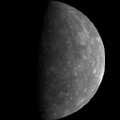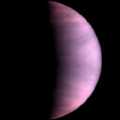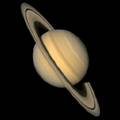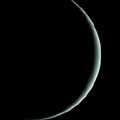ASTRONOMY - THE SOLAR SYSTEM
The solar system is about 4.6 million years old. It began as a spinning disc of hydrogen and helium which, over a period of 25 million years, formed into the sun and surrounding planets.

THE SUN
The Sun is a nuclear reactor generating energy by the conversion of hydrogen into helium. The rate of conversion is relatively slow, there is enough hydrogen for another 15 billion years.
The granular surface (photosphere) is constantly changing, the main features of which are sunspots and erupting jets of gas (spicules). Above the surface is a hydrogen chromosphere and beyond this is the corona. The Sun is classified as a G2 yellow dwarf.
THE TERRESTRIAL PLANETS
The inner four planets all have an iron core, rock mantle and a crust of varying thickness.
MERCURY
 |
Mercury, the innermost planet, is heavily cratered, very hot and has virtually no atmosphere. It spins very slowly, only three times in every two orbits of the sun.
Mean Orbit: 57 909 100 km Mean Diameter: 4 878 km Orbital Period1: 88.0 days Mass: 0.055 Satellites: None |
VENUS
 |
Venus is often the brightest object in the night sky due to the reflective cloud layer, the result of a hot carbon-dioxide atmosphere. The rocky surface is relatively flat with two pronounced highland regions, a temperature of over 800 C and prone to violent volcanic activity.
Mean Orbit: 108 208 600 km Mean Diameter: 12 102 km Orbital Period1: 224.7 days Mass: 0.815 Satellites: None |
EARTH
 |
The third planet, Earth, is so far the only one known to support life. Two thirds of the surface is covered by water and the atmosphere is mostly nitrogen-oxygen. See previous chapters for more information.
Mean Orbit: 149 598 600 km Mean Diameter: 12 756 km Orbital Period1: 365.3 days Mass: 1.000 Satellites: Moon |
MARS
 |
Mars: the red planet. The surface is barren and cratered with massive volcanos, deep chasms and two small polar ice caps. The red colour comes from the iron rich sand that is literally rusty. Mars has a thin carbon-dioxide atmosphere.
Mean Orbit: 227 939 200 km Mean Diameter: 6 794 km Orbital Period1: 687.0 days Mass: 0.107 Satellites: Phobos, Deimos. |
THE GAS GIANTS
So called because of their gaseous surfaces (albeit frozen), all the gas giants have ring systems of dust and ice fragments. In some cases the rings are 'shepherded' by small satellites.
JUPITER
 |
The largest planet in the solar system. Jupiter has a rocky core and a hydrogen/helium atmosphere the inner layers of which are very dense. The atmosphere is distorted by the high rotational speed causing the equator to budge. The circulating winds form coloured belts that include a huge storm called the Great Red Spot. The outermost satellites are probably captured asteroids.
Mean Orbit: 778 298 400 km Mean Diameter: 142 984 km Orbital Period11: 11.9 years Mass2: 317.828 Satellites: Metis, Adastra, Almathea, Thebe, Io, Europa, Ganymede, Callisto, Leda, Himalia, Lysithea, Elara, Ananke, Carme, Pasiphae, Sinope. |
SATURN
 |
Very similar to Jupiter in composition. Saturn has a distinctive ring system split into 7 main bands each containing hundreds of separate rings.
Mean Orbit: 1 426 394 000 km Mean Diameter: 120 536 km Orbital Period1: 29.5 years Mass2: 95.161 Satellites: Pan, Atlas, Prometheus, Pandora, Epimetheus, Janus, Mimas, Enceladus, Tethys, Telesto, Calypso, Dione, Helene, Rhea, Titan, Hyperion, Iapetus, Phoebe. |
URANUS
 |
Uranus, the seventh planet, has a rocky core, a frozen shell of water, methane and ammonia, and an atmosphere of hydrogen, helium and methane. Uranus has nine rings and the axis is horizontal: it rolls rather than spins round the sun.
Mean Orbit: 2 875 039 000 km Mean Diameter: 51 118 km Orbital Period1: 84.0 years Mass2: 14.536 Satellites: Cordelia, Ophelia, Bianca, Cressida, Desdemona, Juliet, Portia, Rosalind, Belinda, Puck, Miranda, Ariel, Umbriel, Titania, Oberon. |
NEPTUNE
 |
The structure of Neptune is similar to that of Uranus. The atmosphere contains distinctive, blue, fast moving clouds and the Great Dark Spot; a storm the size of Earth about which a smaller storm, the Scooter, orbits.
Mean Orbit: 4 504 450 000 km Mean Diameter: 49 600 km Orbital Period1: 164.8 years Mass2: 17.132 Satellites: Naiad, Thalassa, Despina, Galatea, Larissa, Proteus, Triton, Nereid. |
PLUTO
 |
Pluto is a small rocky planet with a thick ice mantle that orbits high out of the elliptic and, until 1999, was inside the orbit of Neptune.
Mean Orbit: 5 913 490 000 km Mean Diameter: 2 894 km Orbital Period1: 248.5 years Mass2: 0.002 Satellites: Charon. |
1. The orbital (sidereal) period is measured in "Earth" units. For example: 1 Mercury year = 88 Earth days.
2. The masses of the planets are given relative to the mass of the Earth which is 6 × 1021 tonnes.
2. The masses of the planets are given relative to the mass of the Earth which is 6 × 1021 tonnes.